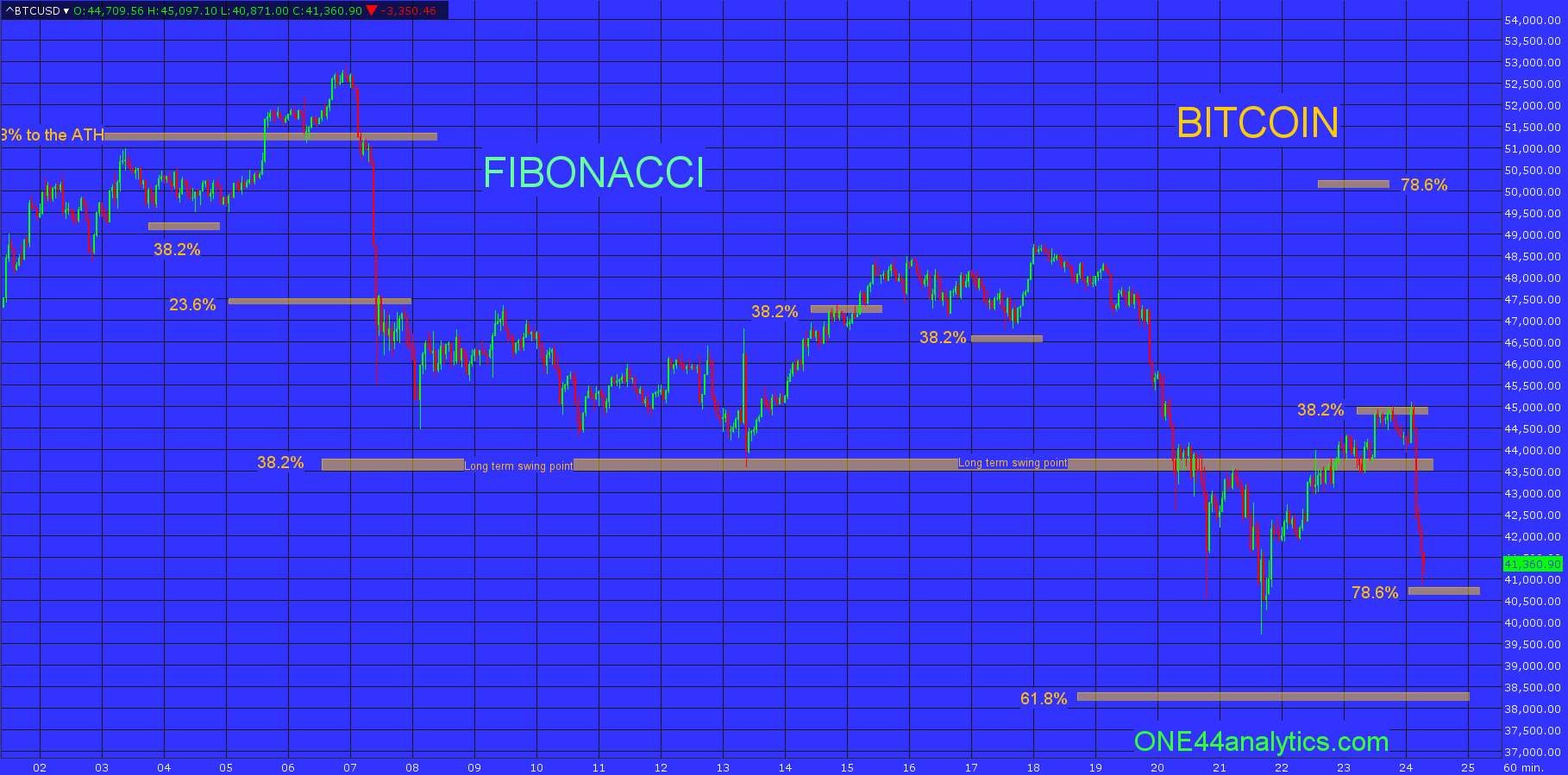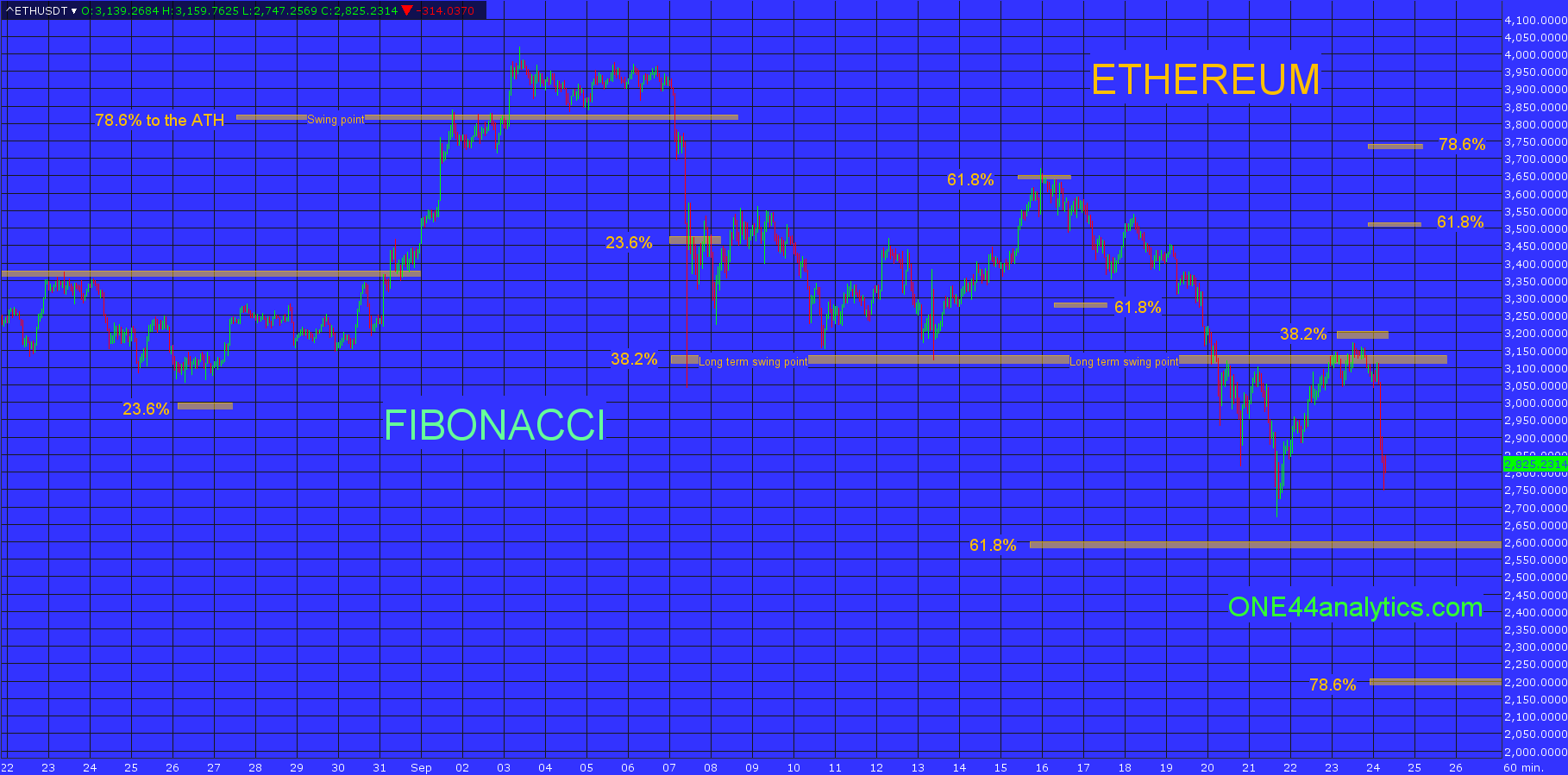Bitcoin, Ethereum hit 38.2% and the news follows
ONE44 Analytics where the analysis is concise and to the point
Our goal is to not only give you actionable information, but to help you understand why we think this is happening based on pure price analysis with Fibonacci retracements, that we believe are the underlying structure of all markets and Gann squares.
Here is a quick set of guidelines for the Fibonacci retracements to help with this article. You can find all the rules/guidelines and examples on any deviations from these four basic rules on our website.
1) The Golden rule, any market that is going to continue the current trend must hold 38.2% and a new high/low should follow.
2) Markets that are extremely strong/weak will only go 23.6% and a new high/low should follow. Typically a runaway market.
3) The 61.8% rule is, any market that holds 61.8% should go 61.8% of where it just came from. Usual happens when a market is directionless, or in a consolidation period.
4) The 78.6% rule is, any market that holds 78.6% should go 78.6% of where it just came from. This is also where a lot of Bull markets end and start.
Charts are courtesy of Barchart.com
Bitcoin
On 9/21/21 we left you with...
Provided it closed back above the long term swing point today, it would still need to take out 38.2% of the current break at 45,400 to say they should go for the 9/7/21 high again.
On the next day it made a lower low and the 38.2% level came down to 44,750. Overnight it hit this level and the sharp break followed. We know by using the ONE44 Fibonacci rules and guidelines that holding the 38.2% retracement should send it to new lows. Provided it did, we would then look to our longer term target of 61.8% of the ATH and the 6/22/21 low, this is 38,200. We got this target when it hit 61.8% at 51,200, using the 61.8% rule we should be looking for 61.8% the other way.
Back to the short term, a failure to make a new low on the break from 38.2% (44,750) should send it up to 61.8% of the same move and this is 47,800. The other thing to watch, if it does not make a new low is the 78.6% level, this is the low this morning and as the second part of the 78.6% rule says, "This is also where a lot of Bull markets end and start." Again, this is the short term view.
This was posted on 9/12/21 and still holds true,
Failing to hold the long term swing point should send it to 61.8% and most likely it goes into a wide trading range between the June low and Sept. high for the next few months.

Ethereum
The post on 9/21/21 still holds true with one exception below.
The rally from the long term swing point of 3150.00 was only able to get to 61.8% of the break from the 9/3/21 high. As we said above, a failure to make a new high after holding 38.2% should send it to 61.8% of the same move. Since the high was in the 78.6% area, the target from there is 78.6% based on the 78.6% rule and this is 2200.00. These levels are possible with another close below the long term swing point. With a close back above it, it would still have to take out 38.2% of the current break at 3290.00 to say it is going for the highs again.
Today
Like Bitcoin the 38.2% level moved down to 3180.00 with the new low on the 22nd and this was where the sharp break came from. With a new low you can also look for 61.8% at 2600.00 and then the long term target of 2200.00. A failure to make a new low after hitting the 38.2% area (3180.00) should send it to 61.8% of the same move at 3500.00.

Sign up for our Free newsletter here.
FULL RISK DISCLOSURE: Futures trading contains substantial risk and is not for every investor. An investor could potentially lose all or more than the initial investment. Commission Rule 4.41(b)(1)(I) hypothetical or simulated performance results have certain inherent limitations. Unlike an actual performance record, simulated results do not represent actual trading. Also, since the trades have not actually been executed, the results may have under- or over-compensated for the impact, if any, of certain market factors, such as lack of liquidity. Simulated trading programs in general are also subject to the fact that they are designed with the benefit of hindsight. No representation is being made that any account will or is likely to achieve profits or losses similar to those shown. Past performance is not necessarily indicative of future results.
